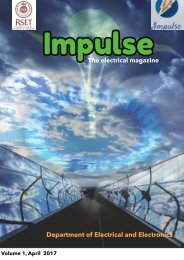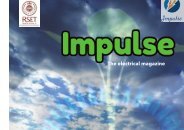impulse-ed 2-060417
Create successful ePaper yourself
Turn your PDF publications into a flip-book with our unique Google optimized e-Paper software.
IMPULSE 2017<br />
DEE, RSET<br />
PEROVSKITE EDGES CAN BE TUNED FOR<br />
OPTOELECTRONIC PERFORMANCE - LAYERED 2D<br />
MATERIAL IMPROVES EFFICIENCY FOR SOLAR<br />
CELLS AND LEDS<br />
In the eternal search for next generation high-efficiency solar cells and LEDs, scientists at Los<br />
Alamos National Laboratory and their partners are creating innovative 2D layer<strong>ed</strong> hybrid<br />
perovskites that allow greater fre<strong>ed</strong>om in designing and fabricating efficient optoelectronic<br />
devices.It mainly includes Industrial and consumer applications like low cost solar cells, LEDs,<br />
laser diodes, detectors, and other nano-optoelectronic devices.<br />
The material is a layer<strong>ed</strong> compound, a stack of 2D layers of perovskites with nanometer thickness<br />
(and the 2D perovskite layers are separat<strong>ed</strong> by thin organic layers.This work could overturn<br />
conventional wisdom on the limitations of device designs bas<strong>ed</strong> on layer<strong>ed</strong> perovskites."<br />
The 2D, near-single-crystalline "Ruddlesden-Popper" thin films have an out-of-plane orientation<br />
so that uninhibit<strong>ed</strong> charge transport occurs through the perovskite layers in planar devices. At the<br />
<strong>ed</strong>ges of the perovskite layers, the new research discover<strong>ed</strong> "layer-<strong>ed</strong>ge-states," which are key to<br />
both high efficiency of solar cells (>12 percent) and high fluorescence efficiency (a few tens of<br />
percent) for LEDs. The spontaneous conversion of excitons (bound electron-hole pairs) to free<br />
carriers via these layer-<strong>ed</strong>ge states appears to be the key to improving the photovoltaic and lightemitting<br />
thin-film layer<strong>ed</strong> materials.<br />
Moreover, once carriers are trapp<strong>ed</strong> in these <strong>ed</strong>ge states, they remain protect<strong>ed</strong> and do not lose<br />
their energy via non-radiative processes. They can contribute to photocurrent in a photovoltaic<br />
(PV) device or radiatively recombine efficiently for light-emission applications. "These materials<br />
are quantum hybrid materials, possessing physical properties of both organic semiconductors and<br />
inorganic semiconducting quantum wells.These results<br />
address a long-standing problem not just for the perovskite<br />
family, but relevant to a large group of materials where <strong>ed</strong>ges<br />
and surface states generally degrade the optoelectronic<br />
properties, which can now be chemically design<strong>ed</strong> and<br />
engineer<strong>ed</strong> to achieve efficient flow of charge and energy<br />
leading to high-efficiency optoelectronic devices.<br />
Scientists at Los Alamos National Laboratory and their<br />
research partners are creating innovative 2-D layer<strong>ed</strong><br />
hybrid perovskites that allow greater fre<strong>ed</strong>om in designing and fabricating efficient optoelectronic<br />
devices<br />
Ms. ANN CHERIACHEN THOPPIL<br />
S8 EEE




